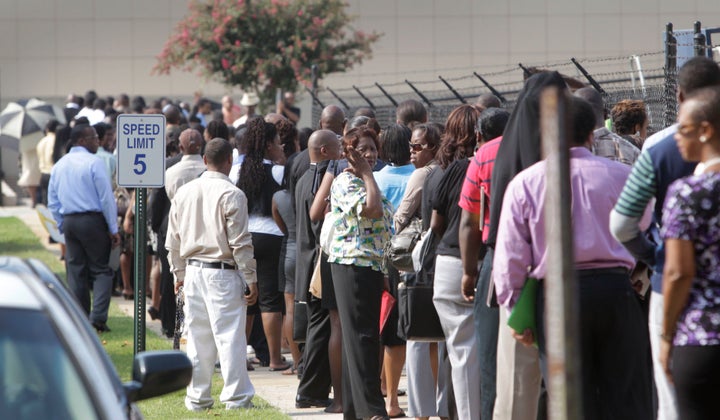
The number of Americans living in poverty in 2010 hit a 52-year high, according to a report released by the U.S. Census Bureau today. As the poverty rate continues to climb, the median household income has tumbled, as has the number of people with health insurance coverage. The news is a sad indicator particularly for the state of black financial health, revealing that blacks have the highest rate of poverty and the lowest median income.
In the report, "Income, Poverty, and Health Insurance Coverage in the United States: 2010," a staggering picture emerges of a still-ailing American economy. The findings detailed in the report are from the first full calendar year since the official end of the 2007-2009 recession.
Between 2009 and 2010, the number of people living in poverty rose by 2.6 million, from 43.6 to 46.2 million people, according to the report. The numbers reflect a dire trend; it is the fourth consecutive annual increase, reaching the highest level in the 52 years that the Census Bureau has tracked the statistics.
The number of blacks living under the poverty line -- which is $11,139 for an individual in 2010 -- rose to 10.7 million, up 1.6 percent. In all, 27.4 percent of blacks were living in poverty.
Median household income in 2010 was $49,445, a dip of 2.3 percent from the previous year. The median income for black households in 2010 was $32,068, down 3.2 percent from $33,122. The median income for white households also dropped, to a lesser degree, from $52,717 to $51,846, a decline of 1.7 percent. (Median income for Asian and Hispanic households was not statistically different.)
The overall poverty rate last year was 15.1 percent, an uptick from 14.3 percent. It is the third consecutive year that the poverty rate has risen. The 2010 rate was the highest since 1993, the report noted, but was 7.3 percentage points lower than the poverty rate in 1959. Between 2007 and 2010 the poverty rate increased by 2.6 percentage points.
"It was a surprisingly large increase in the overall poverty rate," Arloc Sherman, senior researcher at the Center on Budget and Policy Priorities, told the New York Times. "We see record numbers and percentages of Americans in deep poverty."
There were 9.2 million families living in poverty in 2010, up 11.1 percent from the previous year. And the poverty rates increased for married couples and female-headed households alike. To get a clearer picture of just how troubling that number is, consider that the poverty line in 2010, for a family of four, was $22,314.
The number of people without health insurance coverage also rose, from 49 million in 2009 to 49.9 million in 2010. Though the number of individuals increased, the percentage without coverage (16.3 percent) was not statistically different from the rate in 2009, according to the Census Bureau.
The Census Bureau findings piggyback on an earlier study published by the Pew Research Center that showed the gap between the average black and average white households in 2009 grew to proportions unseen since the 1980s.
Median white household wealth was about $113,000. For black families it was about $5,700. And median Latino household wealth was $6,300.
Black unemployment hit 16.7% in August, its highest level since 1984, according to the Labor Department.
"This month's numbers continue to bear out that longstanding pattern that minorities have a much more challenging time getting jobs," Bill Rodgers, chief economist with the Heldrich Center for Workforce Development at Rutgers University told CNNmoney earlier this month.
"Behind today's grim statistics are real people who are finding it harder than ever to keep a roof over their heads, feed their families, get the health care they need and give their children a chance at a better life," Joan Entmacher, vice president for Family Economic Security at the National Women's Law Center, said to the Washington Post.
Economists expect the health care reform law passed by Congress last year to reverse the trend of people losing insurance coverage in 2014, when the law's major provisions kick in.
A temporary program created by the law to cover the uninsured has so far produced lackluster results, reaching only 21,000 people -- far below its expected enrollment. The administration has estimated that as many as 25 million uninsured Americans have pre-existing conditions such as heart disease and diabetes.
Alice O'Connor, a historian at the University of California, Santa Barbara, and author of "Poverty Knowledge: Social Science, Social Policy and the Poor in Twentieth Century U.S. History," told The Huffington Post that explanations for rising poverty often focus on the work ethic and personal choices of the poor. But many still fail to understand how social policies -- such as those that make collective bargaining difficult, or tax income from work and investments differently -- contribute to increased poverty.
The Great Recession, she said, for many has been something of an eye-opener.
"What we are looking at today is really the result of decades of eroded protections for workers and just a declining number of good jobs," she said, noting that public health insurance programs for poor children and adults and cash welfare assistance and other social safety net measures have been slashed.
CORRECTION: An earlier version of this piece misstated that 27.4 million African Americans were living under the poverty line in 2010. The percentage of African Americans living under the poverty line in 2010 was 27.4 percent.